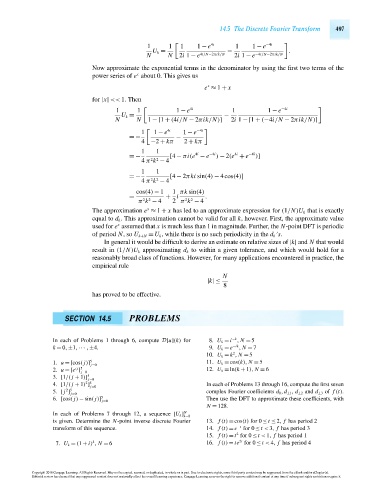Page 517 - Advanced engineering mathematics
P. 517
14.5 The Discrete Fourier Transform 497
1 1 1 1 − e 4i 1 1 − e −4i
U k = − .
N N 2i 1 − e 4i/N−2πik/N 2i 1 − e −4i/N−2πik/N
Now approximate the exponential terms in the denominator by using the first two terms of the
x
power series of e about 0. This gives us
x
e ≈ 1 + x
for |x| << 1. Then
1 1 1 − e 4i 1 1 − e −4i
U k = −
N N 1 −[1 + (4i/N − 2πik/N)] 2i 1 −[1 + (−4i/N − 2πik/N)]
1 1 − e 4i 1 − e −4i
=− −
4 −2 + kπ 2 + kπ
1 1
4i
4i
=− [4 − πi(e − e −4i ) − 2(e + e −4i )]
4 π k − 4
2 2
1 1
=− [4 − 2πki sin(4) − 4cos(4)]
2 2
4 π k − 4
cos(4) − 1 1 πk sin(4)
= + i .
2 2
2 2
π k − 4 2 π k − 4
x
The approximation e ≈ 1 + x has led to an approximate expression for (1/N)U k that is exactly
equal to d k . This approximation cannot be valid for all k, however. First, the approximate value
x
used for e assumed that x is much less than 1 in magnitude. Further, the N-point DFT is periodic
of period N,so U k+N = U k , while there is no such periodicity in the d k s.
In general it would be difficult to derive an estimate on relative sizes of |k| and N that would
result in (1/N)U k approximating d k to within a given tolerance, and which would hold for a
reasonably broad class of functions. However, for many applications encountered in practice, the
empirical rule
N
|k|≤
8
has proved to be effective.
SECTION 14.5 PROBLEMS
−k
In each of Problems 1 through 6, compute D[u](k) for 8. U k = i , N = 5
k = 0,±1,··· ,±4. 9. U k = e −ik , N = 7
2
10. U k = k , N = 5
5
1. u =[cos( j)] j=0 11. U k = cos(k), N = 5
ij 5 12. U k = ln(k + 1), N = 6
2. u =[e ]
j=0
5
3. [1/( j + 1)]
j=0
2 5
4. [1/( j + 1) ] In each of Problems 13 through 16, compute the first seven
j=0
2 5
5. [ j ] complex Fourier coefficients d 0 ,d ±1 , d ±2 and d ±3 of f (t).
j=0
5
6. [cos( j) − sin( j)] Then use the DFT to approximate these coefficients, with
j=0
N = 128.
N
In each of Problems 7 through 12, a sequence [U k ]
k=0
is given. Determine the N-point inverse discrete Fourier 13. f (t) = cos(t) for 0 ≤ t ≤ 2, f has period 2
transform of this sequence. 14. f (t) = e −t for 0 ≤ t < 3, f has period 3
2
15. f (t) = t for 0 ≤ t < 1, f has period 1
2t
k
7. U k = (1 + i) , N = 6 16. f (t) = te for 0 ≤ t < 4, f has period 4
Copyright 2010 Cengage Learning. All Rights Reserved. May not be copied, scanned, or duplicated, in whole or in part. Due to electronic rights, some third party content may be suppressed from the eBook and/or eChapter(s).
Editorial review has deemed that any suppressed content does not materially affect the overall learning experience. Cengage Learning reserves the right to remove additional content at any time if subsequent rights restrictions require it.
October 14, 2010 16:43 THM/NEIL Page-497 27410_14_ch14_p465-504

